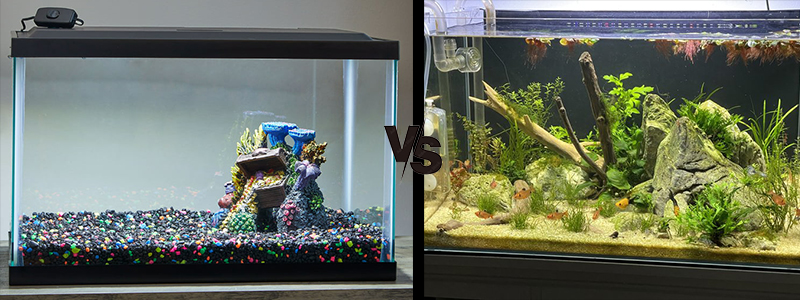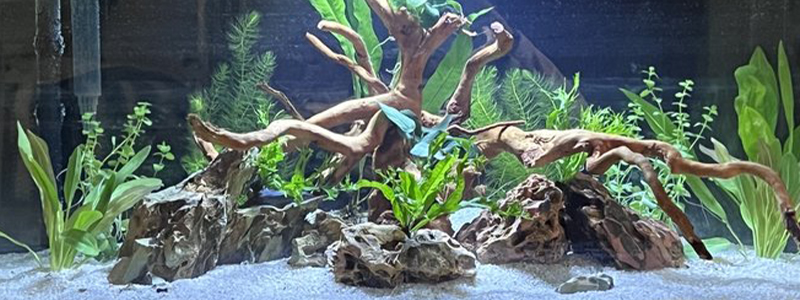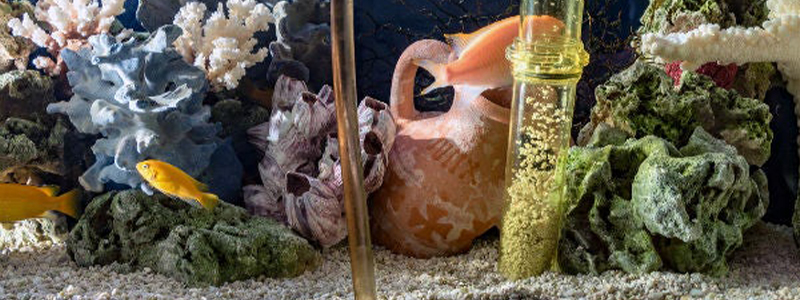When dealing with marine and reef aquarium, it is common to come across bristle worms in fish tanks!
However, what exactly are these organisms, and should you be worried about their presence in your tank? Despite their simplicity, bristle worm in aquarium possess a level of complexity that surpasses initial impressions.
This article aims to provide a detailed understanding of these mysterious creatures, helping you make a wise decision on whether or not they are suitable inhabitants for your fish tank.
What are Bristle Worms?
Long, segmented bristle worms from the Polychaeta class are a common sight in saltwater aquariums. They begin small, at 1.5 inches, and if left unchecked, can grow up to 24 inches.
These nocturnal bristle worm in aquarium keep tanks clean by eating waste. Some types of bristle worms, however, can harm other fish in the tank if they overpopulate. You must avoid touching them because their fine bristles can irritate your skin.
Despite their dreadful appearance and nocturnal habits, reef bristle worms are essential for keeping your tank healthy.
Disclosure: This article contains affiliate links. When you follow a link to purchase the products, I sometime earn a commission, at no additional cost to you. Read my full disclosure here.
What Do Bristle Worms Do?
- Detritivores: Bristle worm in fish tank are naturally occurring detritivores that consume various waste products and aquarium debris.
- Aeration: Similar to earthworms in dirt, bristle worm in aquarium aid in aerating the substrate to stop the buildup of damaging nitrates.
- Algae Control: Their delicate movements in the gravel deter the growth of algae on the tank’s surface.
- Rock Cleaners: Bristle worm in fish tank avoid waste buildup and are considered as rock cleaners.
- Tank Cleanup Crew: Bristle worm in aquarium are helpful individuals as they are a part of your tank’s cleanup crew.
What Does A Bristle Worm Eat?
Bristle worm in aquarium, act as little helper. They consume a wide variety of foods, including algae, corpses, and even leftover fish food. By doing this, you can avoid overfeeding your fish and keep your tank clean. They’re more like garbage pickers than they are interested in attacking live fish.
Bristle worm in fish tank are so good at eating algae that some people purposefully invite them into their tanks. Thus, without the need for additional food, these worms serve as your aquarium’s typical cleaning crew, keeping everything organized and in check.
Types of Bristle Worms
Reef bristle worm, which are frequently viewed as unwanted visitors in reef tanks, are actually important components of the ecosystem.
Despite their unsettling physical appearance, they are vital scavengers who clear away trash and other debris.
It’s important to correctly identify the different types of bristle worms because some of them are good and some of them are bad. While bad bristle worms in fish tank can overrun and damage the tank, good ones support tank health.
Let’s have a look at its different types of bristle worms!
- Linopherus polychaete (commonly known as the bristle worm)
This marine-dwelling creature, commonly introduced to your tank through live rock, has proven to be a valuable asset. Bristle worm in fish tank like Linopherus are classified as detritivores due to their primary diet of small organic particles known as detritus.
They do not pose any harm or danger to fish or corals and instead serve a beneficial role in maintaining the cleanliness of your saltwater aquarium. Bristle worm in aquarium typically exhibit a pinkish hue.
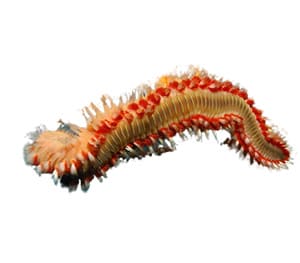
- Red-Tipped Fireworms
Reef bristle worm-like fireworms possess two stripes that run along their dorsal region and are composed of clusters of light-colored spots. Their body, ranging in shades from pink to brown, is adorned with bristles that alternate between white and red hues. Although not as abundant as bearded fireworms, they pose a similar nuisance.
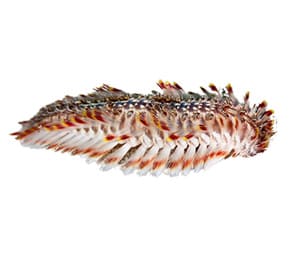
- Bearded Fireworms
On the contrary, bearded fireworms can be quite troublesome. They tend to grow up to 12 inches in length and are notorious for their vibrant bodies adorned with short tufts of white and red bristles. These bristle worm in fish tank have colorful bodies and can range from gray, red, yellow, or green.
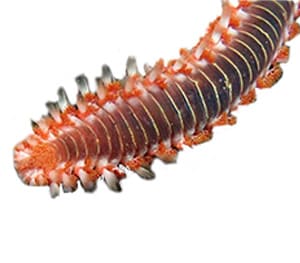
- Giant Bobbit Worm
The Eunice Aphroditois, also known as the Giant Bobbit Worm, can grow up to nine feet in length. These reef bristle worms have a retractable jaw with serrated plates and distinct beaded and banded extensions on their heads. It is important to carefully remove these harmful reef bristle worms from your aquarium to protect your desired inhabitants.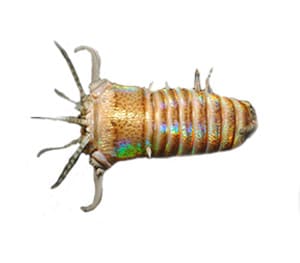
What Is The Difference Between A Bristle Worm and A Fireworm?
Bristle Worms: The Friend
Bristle worms possess distinct segmented biology that sets them apart from ordinary earthworms. Covered in minuscule bristle needles, their bodies can easily puncture the skin and result in irritation. Certain types of bristle worms can even carry toxins.
Therefore, it is better to wear protective gear when handling them. While some types of bristle worms can reach lengths up to 24 inches, those found in reef tanks typically range from 1 to 6 inches long.
Bristle worm in aquarium are primarily active during nighttime hours and tend to hide within rocks or sand during the day, making them inconspicuous in well-lit tank environments.
Fire worms: The Foe
Imagine fireworms as troublesome party crashers who refuse to leave and bring chaos with them. These bristle worm in fish tank are detrimental to the well-being of your aquarium. It is important to make a distinction within the aquarium community, as “fireworms” can be confusing.
We are specifically referring here to the problematic ones belonging to the Pherecardia and Hermodice species. These reef bristle worm pose a threat as they are mobile carnivores that can cause extensive damage by harming corals and occasionally even preying on fish. What makes these reef bristle worm dangerous is their bristle containing stinging toxins.
Removing these bristle worm in fish tank becomes important for maintaining a healthy tank.
Are Bristle Worms Good or Bad?
In reef ecosystems, bristle worm in aquarium can play both beneficial and problematic roles. The helpful varieties contribute to the maintenance of cleanliness by regulating food intake and eliminating algae and waste.
On the other hand, certain types of bristle worms such as the bearded fireworm are dangerous for corals and other fish in tank.
Therefore, it is essential to differentiate between these types of bristle worms to safeguard the overall health of your aquarium.
How to Differentiate Good and Bad Bristle Worms?
Differentiating between friendly and harmful reef bristle worms in your aquarium can be a daunting task, considering the existence of over 120 confirmed fireworm species.
Nevertheless, some common characteristics can serve as indicators:
- Vibrant Colors: Problematic fireworms or bristle worm in fish tank often possess more conspicuous bristles and display vivid shades of red and orange on their bodies.
- Increased Size: They generally exhibit a bulkier physique compared to other types of bristle worms.
- Aggressive Behavior: Typically, reef bristle worm demonstrate increased activity levels and aggressiveness, making them easier to identify, especially when the lights are on during feeding times. If you come across one during mealtime, it is likely to cause trouble.
Best Ways To Get Rid Of Bristle Worms
If you are looking for bristle worm trap in tank, several effective and safe methods can be used to control or eliminate them:
1. Trapping:
Commercial bristle worm traps specifically designed for bristle worms can be purchased to effectively capture them. These bristle worm traps feature entrances for the worms but lack exits, ensuring their effectiveness.
An alternative option is to create your own bristle worm trap by using a bottle or PVC pipe with strategically placed holes and bait. By submerging the bristle worm trap overnight and retrieving it in the morning, you can collect any trapped worms successfully.
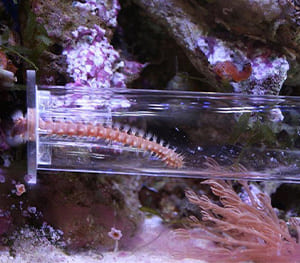
2. Manual Removal
Although it may take more time, bristle worms in aquarium can be manually removed using tongs. It is important to act quickly as these worms are sensitive to light changes. Some hobbyists entice them with food placed on the tongs. For close work, wearing protective gloves is recommended for safety purposes.
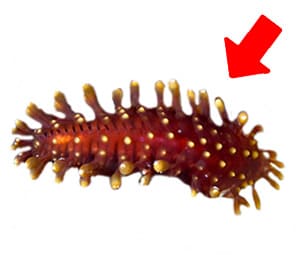
3. Natural Predators:
The introduction of certain tank inhabitants can effectively manage reef bristle worm populations in your aquarium.
- Arrow Crabs: These reef bristle worm predators are known for their efficiency, but it’s important to note that they may pose a threat to corals and slow-moving tankmates. Hence, caution must be exercised if considering them as an option.
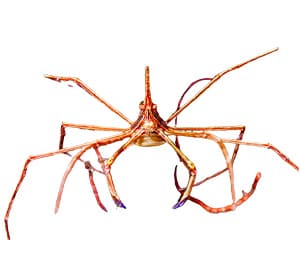
- Wrasses: Colorful and vibrant, wrasses have a strong appetite for bristle worms. However, before introducing them into your aquarium, ensure that they are compatible with the size of your tank and other resident species. Various species of wrasse are available for consideration.
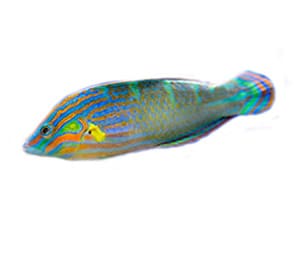
- Other Fish Species: There are also several additional fish species such as goatfish, butterflyfish, and gobies which exhibit natural predation behavior towards types of bristle worms and can contribute towards managing their population within the tank.
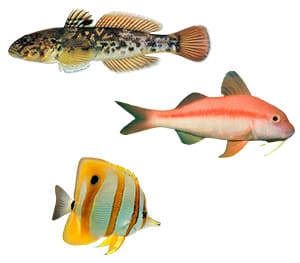
Conclusion
Bristle worms in fish tank are generally beneficial to the ecosystem of your reef tank. But it’s crucial to confirm that they are members of the typical bristle worm species.
To protect the general health of your tank, it is advisable to investigate further if you come across any strange types of bristle worms.
Some bristle worm species have the capacity to multiply rapidly, which could upset the delicate balance of the tank and endanger other inhabitants.

